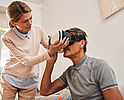Background
Therapeutically guided exposure or confrontation therapy is considered one of the most effective methods for achieving a step-by-step habituation to a phobic trigger and is recommended as first-line therapy for specific phobias according to international guidelines.
In exposure therapy, patients are instructed not to avoid phobic objects or situations, but to seek them out instead. However, in therapeutic practice, carrying out in vivo exposures (i.e. confrontation in the real world) often proves challenging or not feasible. To give an example: when a fear of heights is to be treated under therapeutic supervision at actual heights.
VR technology, which has been used in the treatment of anxiety disorders for several years under the name ‘Virtual Reality Exposure Therapy (VRET)’, is a great support method here. For example, treating a fear of heights would involve going to a rooftop or balcony or another destination which is high up under therapeutic supervision.
VRET allows patients to repeatedly immerse themselves in anxiety-inducing situations, which is an important component of treatment. In addition, the controlled and safe environment of VR allows therapists to adjust the level of difficulty of the exposure and monitor the patient's progress. This helps to find an appropriate balance between facing the anxiety and keeping the patient safe.
Research and studies
The research on the treatment of phobias and anxiety disorders using VR exposure therapy is clear. A current systematic literature analysis from 2022 confirms the high level of evidence for the use of VR. The meta-analysis by van Loenen and colleagues examined the study results of 16 studies and a total of 817 subjects and confirmed the general applicability of VR therapy for various types of anxiety disorders, such as panic disorder, generalised anxiety disorder and social phobias.
Product and partner
In our facilities the ‘VR Coach smart system’ is used. This includes VR scenarios in which users have the opportunity to interact with their environment as well as 360-degree films. The product also offers therapist software. This allows therapists to follow what patients see in VR on a notebook. It can also be used to intervene in what is being experienced. Elements can be added (e.g. talking avatars), allowing the experience to be gradually intensified.
Objectives and target group
Patients often come to inpatient treatment in mental health rehabilitation with depression as their main diagnosis and anxiety disorders as secondary diagnoses, which have a significant influence on the development and maintenance of depressive disorders. As a result, the treatment of anxiety can also play a key role in the genesis of depression.
As a standard, however, exposure therapy is associated with a significant expenditure of time and human resources, which is why it is used far too rarely in inpatient and outpatient therapies. With VR-supported therapy, it becomes possible to offer effective and time-saving exposure treatment that has been proven to be beneficial. The objective of using VR in mental health is therefore to make exposure therapy accessible as a possible treatment option.
In general, VR therapy in mental health at the MEDIAN Group can be used for all patients suffering from an anxiety disorder. A therapist will individually assess whether VR therapy is suitable for the individual patient, based on their specific needs and state of health.
Innovative aspect
Using virtual reality (VR) therapy in the treatment of patients with anxiety disorders offers an innovative approach to improve treatment. By simulating real-life situations in a controlled environment, patients can step by step deal with their fears and learn to cope with them. This enables a customised and interactive therapy that is tailored to the individual needs of each patient. In addition, VR therapy can increase patient motivation and engagement as they can engage in an immersive and engaging experience. Overall, the use of VR therapy in inpatient treatment offers an innovative way to effectively treat anxiety disorders and support the recovery process.
Technology-supported therapies, such as VR therapy, also offer the opportunity to reduce the workload of the treating teams, make everyday treatment more varied and thus further increase the success of therapy and patient satisfaction.
Pilot testing and implementation
The project has been very well received by both patients and therapists and is showing promising initial results. In the patient survey, all patients stated that they would recommend VR therapy to others and over 80% wanted to continue VR exposure therapy. The specialist therapists were also convinced and stated that VR-supported therapy should be included as a standard form of therapy.



